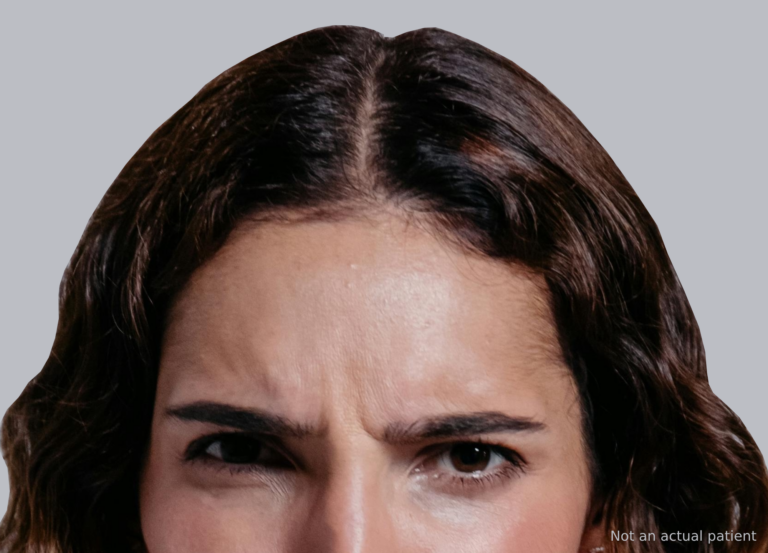“That bump is not supposed to be on the inside of my lip,” a 23-year-old woman said in a recent TikTok video, lifting her upper lip to reveal a hardened nodule underneath. “You know what that’s from? My filler.” With more than 150,000 likes and several thousand comments and shares, the video—and dozens of others like it—has made quite the impression on viewers. But more than that, the TikToks tagged #fillermigration have raised a long list of questions about the phenomenon of dermal fillers spreading to unintended areas of the face, leaving a noticeable bump or series of bumps behind.
It turns out that filler migration is, in fact, not nearly as common of a side effect—or as big a deal—as it seems on the social media platform. (This unlike much more serious filler complications, such as vascular occlusion.) Read on to find out exactly what filler migration is, when and why it occurs, and how to correct it.
What are fillers?
There are several types of dermal fillers, but it’s HA fillers that come with the potential for migration. Made of hyaluronic acid, these type of filler products—common brand names include Juvéderm and Restylane—can be used to restore volume and/or enhance areas such as the lips, nasolabial folds, jawline, cheeks, chin, and under-eyes or tear troughs. (Hyaluronic acid is a sugar molecule naturally found in the body that attracts and retains water.) Alongside Botox, injectable fillers are one of the most popular cosmetic procedures, a quick and relatively easy non-invasive option that’s also very versatile.
What is filler migration?
“Filler migration is a concept where filler is injected in one area but moves to another area,” says Dr. David Shafer, a board-certified plastic surgeon in New York City. “But whether this is the actual intact filler or [the result] of metabolism is unclear.” What’s also unclear is how much of this is filler movement alone and how much may actually be a result of injection technique, the type of filler, or a patient’s reaction to it. However, Dr. Shafer insists, “it must be made clear that filler does not move from one part of the body to another part. What is being described and discussed is small-millimeter migration within anatomic areas.”
Where, when, and why does filler migration occur?
While dermal fillers can technically migrate from any injection site, it’s most likely to occur around the lips or under the eyes. “It usually moves upward [or] downward or protrudes outward, looking like an unnatural path of lumps,” explains Dr. Ava Shamban, a board-certified dermatologist in Beverly Hills, California. Since hyaluronic acid is a natural lubricating material found in our bodies, she says, there is usually no inflammatory response when injected. When the body encounters other inflammation brought on by an illness or injury, however, the cells of the filler can enlarge within the dermal layers and move into what the dermatologist calls “fighting mode,” whereby movement of intracellular and matrix fluids can occur, resulting in migration. “This would not be immediately after having filler but rather, is more likely in filler that was injected months or even years ago and is deep in the dermal layers, even adjacent to the bone,” Dr. Shamban adds.
Does filler migration tend to happen more in certain patients or with certain fillers or techniques?
The very occurence of filler migration is such a rarity that it can often be difficult for doctors to find any real explanation for it, but that hasn’t stopped them from spotting patterns. “It tends to happen when the wrong filler is placed in the wrong area,” says Dr. Shafer. “If a thin and low-cohesive filler is placed in large quantities in an area where a thicker, more cohesive filler would have been the right choice, then that filler will tend to settle or not stay in place.” Similarly, he suggests, if areas are filled beyond their anatomic capacity, then the filler may migrate beyond its intended location.
How is lip filler migration treated?
Depending on the type of filler, the body will likely metabolize the molecules over time, as different fillers have different molecular structures and types of bonds. Even so, Dr. Shamban notes, “the best course of action [in the event of lip filler migration] is to have a highly experienced injector introduce hyaluronidase to the area, and it will dissolve any HA-based filler quickly.” (Hyaluronidase is an enzyme that can dissolve hyaluronic acid fillers.)
How soon after experiencing filler migration can patients get filler again?
After experiencing filler migration, having it dissolved seems like an obvious move, but it might also leave you missing your formerly plumped lips or defined cheekbones. If you find yourself once again itching for filler, Dr. Shafer suggests waiting at least 48 hours after having hyaluronidase injected before having more filler injected.
Can filler migration be avoided or prevented in any way?
Although it’s tough to know how to prevent filler migration, since it’s not clear exactly what the cause is, there are certain steps you can take to potentially avoid this result. “The best approach is serial filler injections, without too much at any one time,” Dr. Shafer says. “Filling in moderation, to prevent overfilling an anatomic area, is also wise, and the choice of filler for the specific area is key to minimizing any complications and maximizing results.” Additionally, the skill and experience of the injector is a crucial factor. “While it’s important to see a board-certified plastic surgeon or dermatologist, you also want to ensure that they are highly experienced and have a busy filler practice,” Dr. Shafer advises. “Even though filler is a safe treatment and has very high patient satisfaction, the skill of the injector can make all the difference.”











